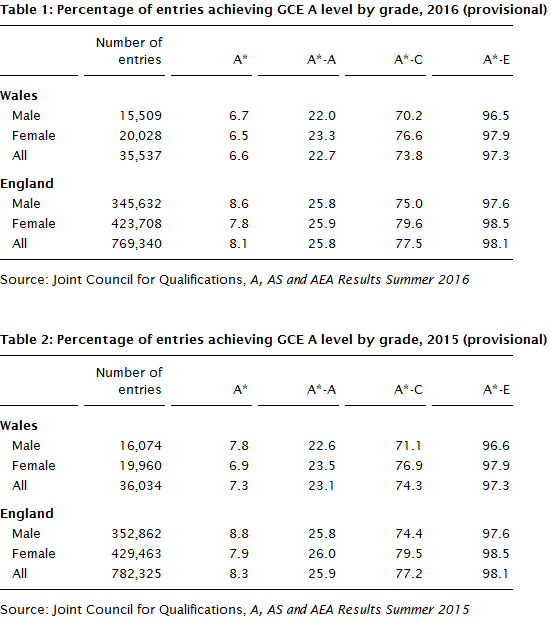Today is A level results day for students in Wales, England and Northern Ireland. The Joint Council for Qualifications (JCQ – a membership organisation comprising the seven providers of qualifications in the UK) publish summaries of the results [PDF 550KB]. The JCQ data shows the collective results of the entries of the member awarding bodies. The results published by the JCQ relate to ‘entries’ and not to ‘candidates’. So, for example, the data can show that performance has increased or declined at A level or within the grades. It cannot show whether more boys or girls achieve two or more passes at A levels. The data relates to the outcome of the individual subject areas for all regardless of their age.
The data in the tables below compare results for 2015 and 2016. This comparison is made based on the data published by JCQ on A level results day in 2015. Data is provisional and they represent the position at the time that results are issued. Data are subject to checking before final data at Wales, local authority and school level is published.
Provisional A level data (entries and not candidates) was published on 18 August 2016.
Comparison between 2015 and 2016
- In Wales and England the overall pass rate has remained the same, 97.3 per cent and 98.1 per cent respectively;
- The percentage of entries achieving grades A*-C has decreased in Wales, by 0.5 per cent to 73.8 per cent with a small increase of 0.3 per cent in England;
- In Wales, there has been a decrease in the percentage of entries achieving A*-A grades by 0.4 per cent to 22.7 per cent. In England there was a decrease of 0.1 per cent;
- In Wales there was a decrease in the percentage of entries achieving grade A*of 0.7 per cent to 6.6 per cent. In England, there was a decrease of 0.2 per cent.
Male and females
- Once again, females continue to achieve better grades than males in both Wales and England, with the exception of the percentage achieving grade A*. In Wales, at grade A* the gap between males and females has decreased from 0.9 per cent to 0.2 per cent;
- In other grades, in Wales, the gap in achievement between males and females has increased since last year at grades A*-A, A*-C and A*-E.
Wales and England
- England continues to achieve better results than Wales, with the gap increasing at all grades except for grades A*-E where the gap remained the same.
Tables 1 and 2 show the percentages of entries in all subjects by grade attained for Wales and England, male and female entries and for 2015 and 2016.

Welsh Baccalaureate
Summer results for the Advanced Welsh Bac are also published today. The Welsh Baccalaureate Qualification is delivered at schools, colleges and training providers throughout Wales. The Welsh Baccalaureate Qualification (Welsh Bac) consists of two parts; ‘Options’ and a ‘Core Programme’. The ‘Options’ must be completed by students studying for all levels of the Welsh Baccalaureate Diploma, and are options selected from established, approved courses or programmes (for example GCSEs, Vocational GCSEs, AS/A Levels, Vocational A Levels).
The ‘Core Programme’ are personal development studies which students must complete along with their Options. To be awarded a Diploma, candidates must meet the requirements of both the Options and the Core. The Core was graded for the first time last year.
At Advanced level:
- There was a percentage increase in candidates being awarded the Advanced Diploma from 87.3 per cent in 2015 to 89.8 per cent in 2016;
- 94.4 per cent of candidates achieving the Core Certificate, compared with 92.2 per cent in 2015;
18.5 per cent achieved grade A* for the Core compared with 12.2 per cent last year.
Article by Sian Hughes, National Assembly for Wales Research Service






